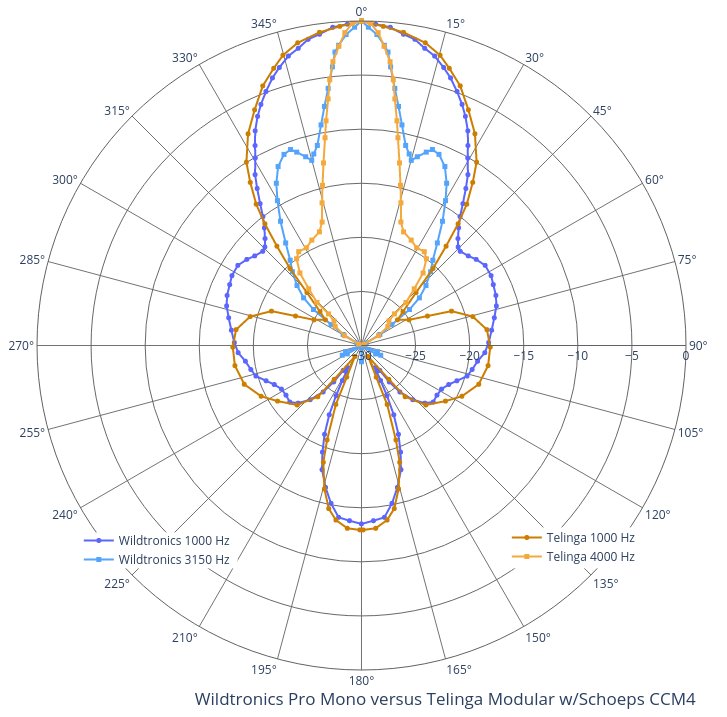
 |
I further mentionned that the Telinga/Schoeps may be more comparable to a long shotgun such as a Rode NTG8 or Sennheiser MKH 8070. In order to be more careful in my statements I have gone ahead and plotted the Telinga/Schoeps against the Rode NTG8 as I already have all the points digitized. This time I am correcting the polar sensitivities to their relative comparable values.
For the Rode NTG8 at 1000 Hz I simply added the microphone sensitivity (-20 dB) to the normalized sensitivity data. At 4000 Hz I refered to the frequency response curve and found a 2.5 dB correction, or -17.5 dB sensitivity to be added. This data ia also shown on my "Rode NT8 versus Sennheiser MKH 8070" page with different scaling.
For the Telinga Schoeps I have digital polar data for which I have added two values, the microphone sensitivity (-37.7 dB) at 1000 Hz plus the 22 inch dish gain operating at 80% efficiency (12.5 dB) equals 25.2 dB at zero degrees polar. For 4000 Hz it is -37.7 dB plus dish gain of 24.6 dB, equals -13.1 dB at zero degrees polar. These two corrections allow plotting the Telinga Schoeps at the same relative scale as the Rode NTG8.

Note on the above polar plot that Telinga is indeed more narrowly focused than the NTG8. The dish gain kicks in rapidly so that by 4000 Hz and above the Telinga is giving superior performance. (Note, the straight line on the Telinga 4000 Hz curve is because there is no data in that range on the original Schoeps plot). Overall though, the Rode NTG8 and the Telinga/Schoeps are indeed comparable and both are significantly lower sensitivity with respect to the Wildtronics.
Assumptions I made include:
Given the same dish/microphone geometry I assume the same polar pattern will be produced. Thus I used the Schoeps polar as my base.
Given that both the schoeps CCM4 and Rode TF5 microphones are 20mm diameter I assume the TF5 will fit into the Telinga blimp.

Wheras the 4000 Hz Telinga curve had a -13.1 dB zero-degree sensitivity with the Schoeps, now you find a -4.4 zero-degree sensitivity with the TF5, an 8.7 dB improvement. Again I need to point out that the Telinga 4000 Hz straight line portion of the curve results from a lack of data on the original Schoeps plot. Also because of the scale change the Telinga curves look moire "puffed out". This is due to scaling and in no way reflects an alteration of the data. This is about as good as you can do.
If you have read this far I salute you! It should be obvious by now that I am rather underwhelmed with the Telinga product. I do not disparage the Telinga workmanship and quality per se, but I feel they charge way way too much for what they offer. Their "Choose-your-own-microphone" concept is fundamentally flawed as it leaves the recordist at the mercy of recording industry microphones where studio conditions and -34 dB sensitivies are the norm. This if fine if you are recording in a studio but for ambient soundscape work more sensitivity is desired.
Basically Telinga is offering VW Beetle performance for a Porch 911 price.

KJS 04/2025